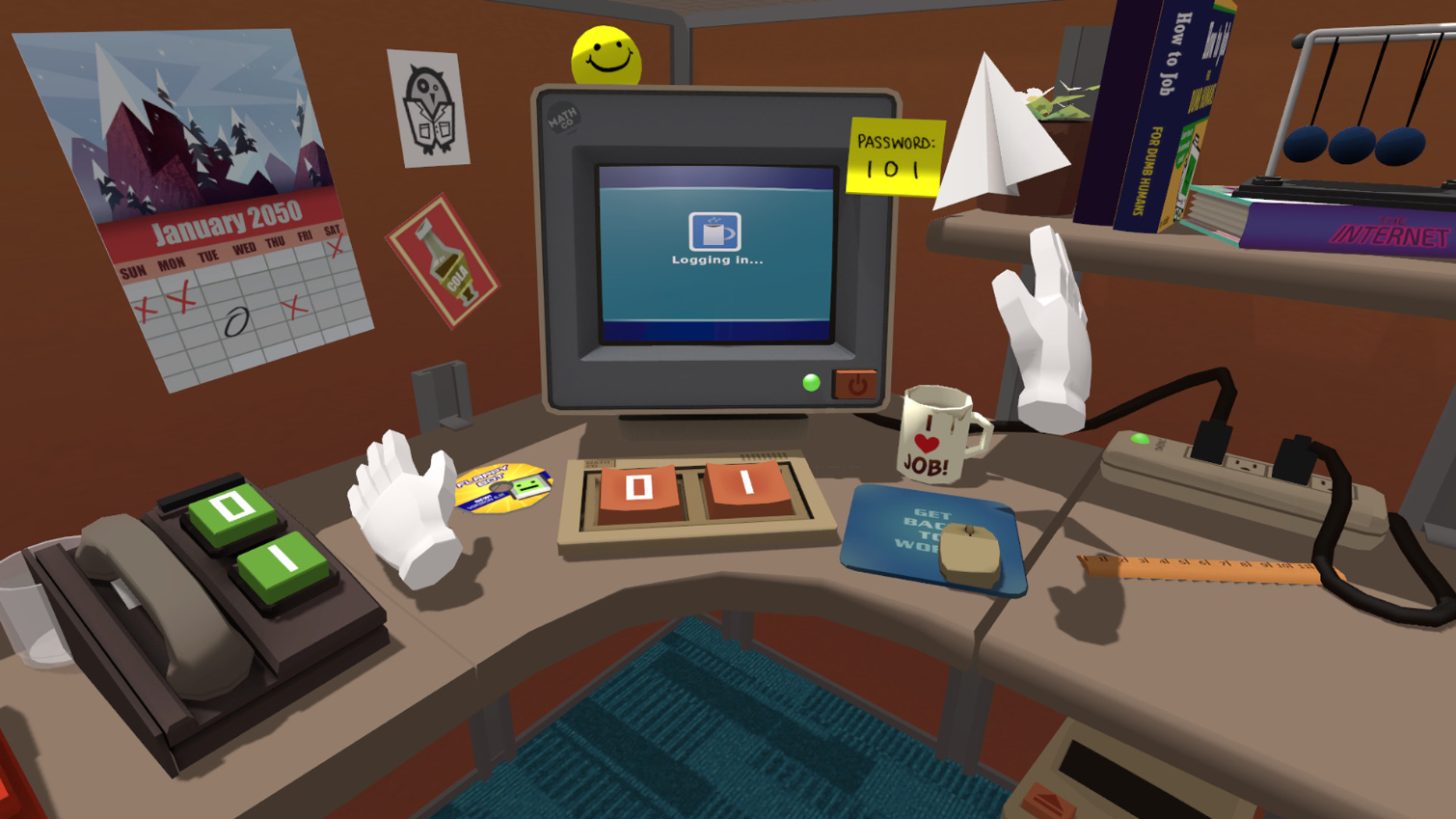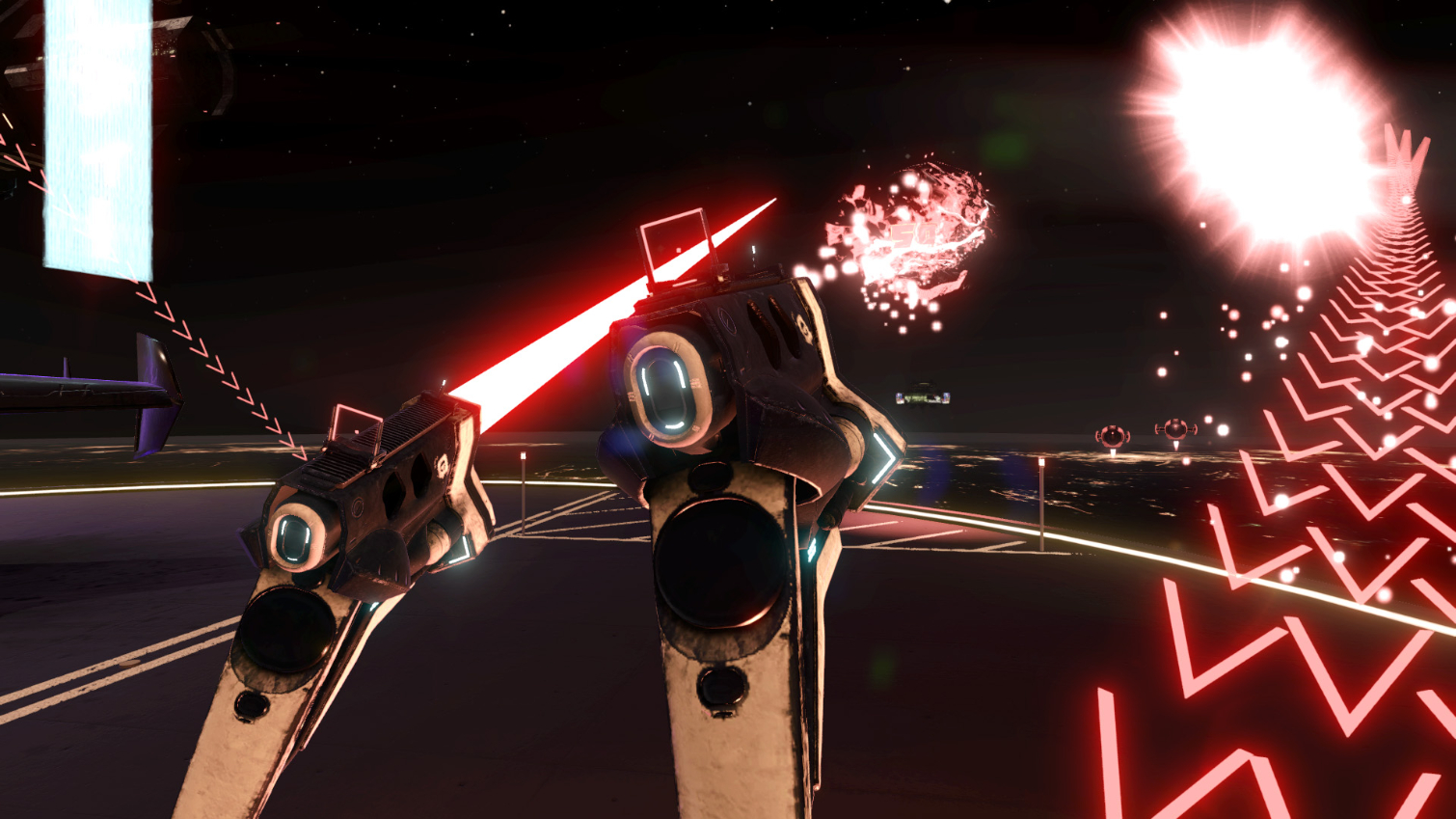The HTC Vive Review
The HTC Vive has all of the ingredients to successfully challenge the Oculus Rift, including its 6DoF hand controllers, the ability to walk around in virtual spaces and 100+ games on the way.
Why you can trust Tom's Hardware
Benchmark Results
Job Simulator
What better place to start testing than one of the titles that has been with us through the hardware's development? Job Simulator was one of the first room-scale experiences shown to the press and public, and it will soon be in the hands of everyone who purchases a Vive. Valve and HTC partnered with Owlchemy Labs to offer the game as bundled title.
To test, we opened up the Office Worker scenario and ran through the same sequence of activities over a two-minute period, making sure to have plenty of head movement to represent what you’ll likely be doing inside the game. There doesn’t appear to be any way to manipulate the graphics settings, so we ran the game as it is.
Job Simulator is very polished, and it presents stable performance, although there are occasional spikes in the frame times.
Curiously, the R9 390X and GTX 970 appeared to encounter significant performance dips. But upon closer examination it turned out that the R9 390X dropped to 47 FPS for a moment and shot right back up to 90 FPS. The GTX 970 hit a similar snag, dipping to 54 FPS within the first five seconds of the test. It raced back to 90 FPS over the next three seconds.
Tilt Brush
Tilt Brush is another title that comes bundled with the hardware. It isn't so much a game as it is an art application. Enthusiasts will spend hours in Tilt Brush, and performance will be key for longer sessions.
Within Tilt Brush, there is a gallery that features pre-drawn art. When you open these images up, the drawing plays out as an animation in front of you. We simply chose the same scene (Sarah Northway’s Space Dragon) and watched it get drawn while walking the same path for each benchmark.
Tilt Brush demonstrated the most consistent frame rates of the five applications we tested. This wasn’t a surprise though, as there's not a lot going on graphically. The test isn't particularly taxing; rather, it's included to demonstrate that you can use lower-end hardware for certain VR applications. Even the R9 285 offers an enjoyable experience.
Get Tom's Hardware's best news and in-depth reviews, straight to your inbox.
Space Pirate Trainer
Spice Pirate Trainer was chosen because it is one of the most active games you can play right now. It’s a first-person gallery shooter that requires you to duck and dodge away from oncoming laser fire while you shoot at flying droids coming from all directions. The action requires that you look around rapidly, which really taxes the GPU.
The benchmark run is simple: just play the game. Space Pirate Trainer restarts at the beginning every round, so for each run we simply recorded data for the first two minutes of game play. Rounds tend to only last a few minutes anyway.
Space Pirate Trainer proved to be taxing on many GPUs. The Radeon R9 285, R9 380X and GeForce GTX 960 fared abysmally in this game. For each of those cards, the droids flying around looked like double-vision as they went by. It was very uncomfortable, and I wouldn’t recommend playing the game with such low performance. The GeForce GTX 780 wasn't even fast enough to deliver consistent frame rates.
The Gallery – Episode 1: Call of the Starseed
The Gallery offers one of the deeper narratives that you’ll find in an early VR game. Cloudhead Games has been working on this title for years, and its hard work is apparent. The environment is rich and the movement system (Blink) that the team created makes traveling through large environments a breeze. This game has plenty of visual flare to take in, and the audio production is impressive. It'll undoubtedly be a popular choice for folks looking for more than just a quick burst of fun.
Our benchmark involves running through the first two minutes of the game over and over. You start off in a cave and make your way to a beach where you discover an abandoned campsite with a burning fire and some loose fireworks. To test the lighting system, we fire off one of the pyrotechnics toward a rock face, which illuminates the scene. Once the firework burns out, we proceed through the caves to the first clue.
The Gallery proved to be the most demanding selection from Valve's list of launch titles. On all of the GPUs that satisfy the platform's recommended hardware list, game play is subjectively smooth. But the same can't be said for the lower-end cards. The GTX 960 and R9 380X were playable, but just barely. Enthusiasts looking to enjoy their first VR experience won't be completely happy with this. And the R9 285 was bad to the point that I had to keep closing my eyes to get through the run. Nvidia's GeForce GTX 780 is by far the worst card in this title. Despite an average frame rate of 70, the spikes up and dips down create a prominent flicker effect.
Vanishing Realms
Vanishing Realms came out of nowhere, but this one is going to impress early adopters. The game was first revealed during this year's GDC, though there was nary an image or video to preview the project. I haven’t had chance to dive deep into the content yet, but the first few minutes hit the right chords.
You play as a hero in an action-adventure RPG (think Link from the Zelda series, only in first-person). You get a sword. You can smash boxes and pottery to collect golden coins and urns. Oh, and you get to fight life-sized sword-wielding skeletons.
For the benchmark run, we started a new save and ran through the first two minutes of the game, following the same path at the same pace each time.
Actually playing through the game, my experience was comfortable and smooth. But when I had a chance to parse the data and look at the frame time graphs, it became clear that a lot of the frames took longer than the 11.1ms corresponding to 90 FPS.
Kevin Carbotte is a contributing writer for Tom's Hardware who primarily covers VR and AR hardware. He has been writing for us for more than four years.
-
comedichistorian Well it looks like as of 7:30 AM on April 5th you can't order one from the official site if you're from the US or Australia. It doesn't say this anywhere on the site, they just won't let you continue on after the order summary. However, if I select "Ireland" as my location I am able to go to the next step and presumably complete the order. Anyone have any ideas as to what this might mean? Anyone else able to actually complete an order after having selected US?Reply -
DrakeFS They have got to do something about that cable. I fully expect a base station and belt receiver accessories to be sold soon, probably not by HTC\Oculus though. The latency that a wireless solution would add to an application sensitive to latency may be the reason both HMDs are cabled. Then again, it could just be cost, after all $800 sounds a lot better than $1000.Reply
Guess if it annoys me enough, I could always do a ceiling mount. -
comedichistorian Ooooh yeah I like that idea. An easy/cheap yet surprisingly reliable option would be one of those Command Strip units. Get a few loops that'll hold 5lbs and mount them wherever needed in your room and you're done. Those things really hold up, I've mounted heavy pictures with them and they've been holding up fine even with all the temp changes and a small quake we got here.Reply -
turkey3_scratch This makes me now want to dish out the extra $200 for this over the Oculus. Except, I actually don't have the open room, I don't even have 5x5 feet so I don't think it's a possibility.Reply -
kcarbotte ReplyThey have got to do something about that cable. I fully expect a base station and belt receiver accessories to be sold soon, probably not by HTC\Oculus though. The latency that a wireless solution would add to an application sensitive to latency may be the reason both HMDs are cabled. Then again, it could just be cost, after all $800 sounds a lot better than $1000.
Guess if it annoys me enough, I could always do a ceiling mount.Ooooh yeah I like that idea. An easy/cheap yet surprisingly reliable option would be one of those Command Strip units. Get a few loops that'll hold 5lbs and mount them wherever needed in your room and you're done. Those things really hold up, I've mounted heavy pictures with them and they've been holding up fine even with all the temp changes and a small quake we got here.
The problem with a ceiling mount is the length of the cable isn't enoug for that.
you'd have to run the cable up the wall, which would require at least 7 feet, likely more, than across the ceiling to your play space - which would be around 5 feet from the wall or more.
You might have enough range to reach your head, but you definitly won't be walking around in a room-scale space like that.
The cable is somethign we're just going to have to live with for now. It's not going away for the first generation, so get used to it. We're looking at probably two years or more with the current hardware before any major iterations hit the market. I may be wrong about that, it could end up being like the cell phone market, but for now, this is what we have to work with.
It's really not as big of a concern as people think. Yes, you are aware of it always. No, it doesn't detract from the experience enough to brush it off due to a tether. -
Borisblade7 ReplyThey have got to do something about that cable. I fully expect a base station and belt receiver accessories to be sold soon, probably not by HTC\Oculus though. The latency that a wireless solution would add to an application sensitive to latency may be the reason both HMDs are cabled. Then again, it could just be cost, after all $800 sounds a lot better than $1000.
Yeah its teh latency added by the wifi. Until someone finds some work around, its going to be cabled. It doesnt matter so much with the Rift since you can only sit on your ass and play it, but with this being superior with its ability to actually move around, being tethered can cause issues. Having said that, most every vid i've seen of people using this, it really wasnt much of an issue.
-
kcarbotte ReplyThis makes me now want to dish out the extra $200 for this over the Oculus. Except, I actually don't have the open room, I don't even have 5x5 feet so I don't think it's a possibility.
You can filter the SteamVR store to show you what is available for Standing experiences. These games still use the hand controlls, but they don't required that you walk around.
A quick search on steam showed there are 54 titles that support standing configurations and don't need room scale.
Over 30 of those titles launched today and are true VR games designed from the ground up on Vive.
http://store.steampowered.com/search/#sort_by=Released_DESC&sort_order=DESC&category1=998&tags=-1&vrsupport=101%2C302&page=1
-
kcarbotte ReplyThey have got to do something about that cable. I fully expect a base station and belt receiver accessories to be sold soon, probably not by HTC\Oculus though. The latency that a wireless solution would add to an application sensitive to latency may be the reason both HMDs are cabled. Then again, it could just be cost, after all $800 sounds a lot better than $1000.
Yeah its teh latency added by the wifi. Until someone finds some work around, its going to be cabled. It doesnt matter so much with the Rift since you can only sit on your ass and play it, but with this being superior with its ability to actually move around, being tethered can cause issues. Having said that, most every vid i've seen of people using this, it really wasnt much of an issue.
For smooth graphics in VR, the target is 11.11ms of latency. GPUs are just barely able to deliver that reliably over HDMI, adding a wireless signal in there will make it far higher, making it infeasible for the majority of people.
I'm sure there's a wireless version in some research lab somewhere, but we're likely going to have to wait a while for that to hit consumer markets. -
hoofhearted Intel NUC, GTX980 MXM, a lith battery and a backpack will solve the cable issue. Maybe something that converts methane gas to electricity combined with an anal probe will solve the power issue. Throw in a free can of beans.Reply




